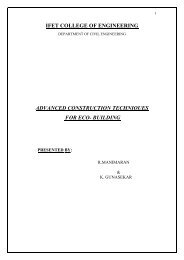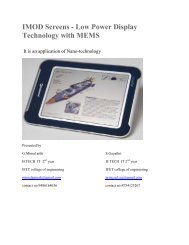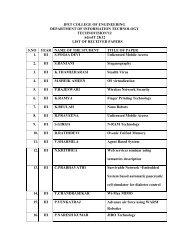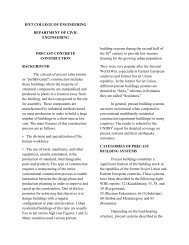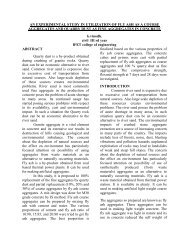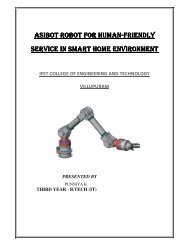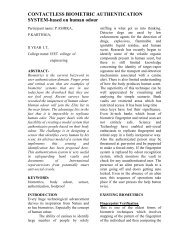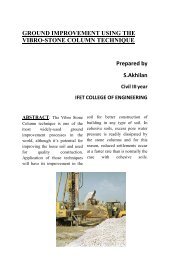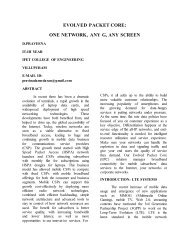Mobile Phone Based Drunk Driving Detection - IFET College of ...
Mobile Phone Based Drunk Driving Detection - IFET College of ...
Mobile Phone Based Drunk Driving Detection - IFET College of ...
Create successful ePaper yourself
Turn your PDF publications into a flip-book with our unique Google optimized e-Paper software.
<strong>IFET</strong> COLLEGE OF ENGINEERING<strong>Mobile</strong> <strong>Phone</strong> <strong>Based</strong> <strong>Drunk</strong> <strong>Driving</strong> <strong>Detection</strong>Presented By:N.Kaviyarasu,Ece-A IIIyear.
<strong>Mobile</strong> <strong>Phone</strong> <strong>Based</strong><strong>Drunk</strong> <strong>Driving</strong> <strong>Detection</strong>Abstract<strong>Drunk</strong> driving, or <strong>of</strong>ficially driving underthe Influence (DUI) <strong>of</strong> alcohol, is a majorcause <strong>of</strong> traffic accidents throughout theworld. In this paper, we propose a highlyefficient system aimed at early detection andalert <strong>of</strong> dangerous vehicle maneuverstypically related to drunk driving. The entiresolution requires only a mobile phone placedin vehicle and with accelerometer andorientation sensor. A program installed onthe mobile phone computes accelerationsbased on sensor readings, and comparesthem with typical drunk driving patternsextracted from real driving tests. Once anyevidence <strong>of</strong> drunk driving is present, themobile phone will automatically alert thedriver or call the police for help well beforeaccident actually happens. We implementthe detection system on Android G1 phoneand have it tested with different kinds <strong>of</strong>driving behaviors. The results show that thesystem achieves high accuracy and energyefficiency.INTRODUCTIONMotivationCrashes caused by impairment <strong>of</strong> alertnessin vehicle drivers pose a serious danger topeople, not only to drivers themselves butalso <strong>of</strong>ten to the general public. Accordingto the report <strong>of</strong> U.S. National HighwayTraffic Safety Administration (NHTSA),more than a million people have died intraffic crashes in the United States since1966. During these tragedies, drunk drivingis one <strong>of</strong> the main causes. The concernrelated to drunk driving is not only the highcrash rate, but also the type <strong>of</strong> crashes thatare most likely to happen. In the last twoyears,2007 and 2008, 13,041 and 11,773 alcoholimpaireddriving fatalities happened,respectively. Both are 32% <strong>of</strong> the totalfatalities <strong>of</strong> that year [2]. During thesecrashes, tens <strong>of</strong> thousands <strong>of</strong> people werekilled, and much more people injured.Besides being a great threat to public safetyand health, drunk driving also imposes aheavy financial burden on the whole society,especially on the healthcare sector.According to U.S. Central <strong>of</strong> Disease control(CDC), the annual cost <strong>of</strong> alcohol relatedcrashes totals more than $51 billion in 2008.Lee etal. pointed out in their work [4] thatthe emergency department spends $4; 538more on average in treating alcoholimpairedmotor vehicle crash victims,especially for patients who are minimallyinjured, because <strong>of</strong> their impaired reasoningand blunted sensation. Despite the fact thatdrunk driving is a serious problem, itsdetection has been so far relying on visualobservations by patrol <strong>of</strong>ficers. Driversunder the influence <strong>of</strong> alcohol show amarked decline <strong>of</strong> perception, recognition,and vehicle control, so they tend to makecertain types <strong>of</strong> dangerous maneuvers. TheU.S. NHTSA has conducted extensivestudies in their effort to help distinguishthese maneuvers. During field studiesinvolving hundreds <strong>of</strong> <strong>of</strong>ficers and morethan 12,000 enforcement stops, theresearchers have identified cues <strong>of</strong> typicaldriving behavior for drunk drivers, namelyproblems in maintaining proper laneposition, speed and braking problems,vigilance problems and judgment problems.These are guidelines for patrol <strong>of</strong>ficers tostop a suspect drunk driver and give him analcohol test. However, relying on visualobservation <strong>of</strong> patrol <strong>of</strong>ficers to preventdrunk driving is insufficient. First <strong>of</strong> all,given the huge mileage <strong>of</strong> driveways inUSA, the number <strong>of</strong> patrol <strong>of</strong>ficers is farfrom enough to observe and analyze everydriver’s behaviors. Second, the guidelines <strong>of</strong>drunk driving patterns are only descriptive
and qualitative. Sometimes it is not easy totell whether a vehicle is performing thatexact type <strong>of</strong> movements or not, especiallywhen it is dark with poor sight range orother obstructions are present in the middle.In fact, U.S. CDC has reported that eachyear only less than 1% <strong>of</strong> the drunk driversare arrested and more than 99% <strong>of</strong> selfallegeddrunk driving episodes go unnoticed.It is also imaginable that even a drunk driveris stopped by a patrol <strong>of</strong>ficer; the driver mayhave been on the way for dozens <strong>of</strong> miles.So it is essential to develop systems activelymonitoring drivers’ operating situations andalerting <strong>of</strong> any insecure conditions toprevent accident. It is preferable that theactively monitoring system satisfies thefollowing requirements: a real-timemonitoring system with quick response; areliable system performing accurately; anonintrusive system and a low cost system.Our ContributionsIn this paper, we propose utilizing mobilephones as the platform for drunk drivingdetection system development, as theynaturally combine the detection andcommunication functions. To the best <strong>of</strong> ourknowledge, we are the first to do so. As aself-contained device, mobile phonepresents a mature hardware and s<strong>of</strong>twareenvironment for the development <strong>of</strong>Active drunk driving monitoring system.The system based on mobile phone canfunction effectively on its own becausemobile phones are highly portable, allnecessary components are already integratedtherein, and their communication serviceshave vast coverage. The minimumrequirement for such a mobile phoneplatform is the presence <strong>of</strong> simple sensors,e.g., accelerometer and orientation sensor.Currently, many phones, especiallysmartphones, meet this requirement. Theycontain multiple types <strong>of</strong> sensors, includingaccelerometers and orientation sensors. Andtheir communication module and speakersare naturally good enough for alerting. Suchphonesare very popular and widely accepted in oursociety. Over 120 million smartphones weresold in 2008, and their popularity isprojected to continuously increase in thenear future due to decreasing price.Recently, several leading telecommunicationcompanies such as AT&T have madeavailable affordable smartphones, whosefeatures are similar to those <strong>of</strong> high endmodels, in addition to cheaper service plans.We summarize the contributions <strong>of</strong> thispaper as follows. We propose utilizingmobile phones as the platform for drunkdriving detectionACCELERATION-BASEDDRUNK DRIVING CUESIn this section, we analyze the drunk drivingrelated behaviors and extract fundamentalcues for drunk driving detection.Fig. 1. Problems in maintaining the laneposition : (a) weaving, (b) drifting, (c)swerving, (d) turning with a wide radius [5].Our analysis is based on the accelerations <strong>of</strong>vehicles. In the U.S. NHTSA’s study ondrunk driving, the researchers haveidentified cues <strong>of</strong> typical driving behaviorfor drunk drivers. <strong>Based</strong> on their work, wesummarize these drunk driving relatedbehaviors into three categories. The first andsecond category focus on driving behaviorsrelated to vehicle movement itself, such asthe movement trace or the movement trend;the third category is about the drivingbehaviors related to subjective judgment andvigilance <strong>of</strong> the driver. We present thesethree categories <strong>of</strong> behaviors as follows.
Cues related to lane position maintenanceproblems: such as weaving, drifting,swerving, and turning abruptly, illegally orwith a wide radius.Cues related to speed control problems:such as accelerating or deceleratingsuddenly, braking erratically and stoppinginappropriately (e.g. too jerky).Cues related to judgment and vigilanceproblems: such as driving with tires oncenter or lane marker, driving on the otherside <strong>of</strong> the road, following to closely,driving without headlights at night, and slowresponse to traffic signals. Generally, theprobability for lane position maintenanceproblems is 50.75%, for speed controlproblems 45.70%, for judgment andvigilance problems around 40%. Forexample, if a driver is observed to beweaving, the probability <strong>of</strong> drunk driving forhim is more than 50%. Some cues, such asswerving and accelerating suddenly, havesingle-cue probabilities greater than 70%.Furthermore, the probability <strong>of</strong> drunkdriving increases when a driver exhibitsmore than one <strong>of</strong> the cues. For example, ifthe weaving plus any other cue is observed,the probability <strong>of</strong> drunk driving jumps to atleast 65%. The results suggest that: thesedriving cues provide relatively strongevidence <strong>of</strong> drunk driving; the cues relatedto problems <strong>of</strong> lane position maintenanceand speed control are the main categories,corresponding to higher probabilities<strong>of</strong> drunk driving, so they can be used asmain evidences for drunk driving detection;the probability <strong>of</strong> drunk driving goes higherwhile the number <strong>of</strong> observed cuesincreases. For the purpose <strong>of</strong> developingactively detecting system for drunk driving,we focus on the cues <strong>of</strong> problems <strong>of</strong> laneposition maintenance and speed control. Wemap these cues into lateralacceleration and longitudinal acceleration <strong>of</strong>vehicles.A. Lateral Acceleration and LanePosition MaintenanceApparently, the lateral movement is causedby a steering wheel rotation toward onedirection and a following steering correctiontoward the other direction. Similarly, thedrifting, swerving and turning with a wideradius have the abnormal lateral movements.B. Longitudinal Acceleration andSpeed Control in <strong>Driving</strong>A drunk driver <strong>of</strong>ten experiences difficultyin keeping an appropriate speed. Abruptacceleration or deceleration, erratic brakingand jerky stop are strong cues to show thatthe driveris under alcohol impairment. They will allbe reflected in the changes <strong>of</strong> longitudinalacceleration. We assume that thelongitudinal acceleration is positive towardthe head <strong>of</strong> the vehicle. The abruptacceleration <strong>of</strong> vehicle will lead to a greatincrease <strong>of</strong> longitudinal acceleration(positive values). On the contrary, the abruptdeceleration, erratic braking or jerky stopwill cause a great decrease <strong>of</strong> longitudinalacceleration (negative values). In summary,the patterns <strong>of</strong> lateral acceleration andlongitudinal acceleration <strong>of</strong> a vehicle mayindicate abnormallateral movements and abrupt speedvariations, which reveal the driver’sproblems in maintaining lane position andcontrolling speed.System OverviewThe drunk driving detection system is madeup <strong>of</strong> four components. They are (1)monitoring daemon module, (2) calibrationmodule, (3) data processing and patternmatching module and (4) alert module. Thethird module implements the detectionalgorithm, as marked by a dashed box. Ourdesign is general, not constrained to anyparticular brand or type <strong>of</strong> mobile phone.And our design is also power-aware, ashardware such as the screen is only activatedwhen necessary. After the system starts
manually, a calibration procedure isconducted when the system detects that thephone is located in a moving vehicle. Thenthe main program launches, working as abackground daemon. The daemon monitorsthe driving behaviors in real time andcollects acceleration information. Thecollected information includes lateral andlongitudinal acceleration. They areprocessed separately, and used as inputs tothe multiple round pattern matching process.At the same time, the historical informationwill be registered. This information ishelpful in the following round patternmatching process. If the pattern condition issatisfied, which means a drunk driving isdetected, one signal is transmitted to triggeran alert. The phone may alarm to remind thedriver or automatically contact the police forhelp. If the condition is not satisfied,execution returns to the daemonimmediately.EVALUATIONWe evaluate the drunk driving detectionprototype with real driving tests. In thissection, we first describe how we collect thedata. Then we present the systemperformance in different scenarios and theenergy efficiency.A. Data CollectionWe study drunk driving behaviors in twomain categories: problems <strong>of</strong> lane positionmaintenance and problems <strong>of</strong> speed control.Correspondingly, we have collected the data<strong>of</strong> these two kinds <strong>of</strong> abnormal drivingbehaviors in real driving simulations. Thedata include lateral and longitudinalaccelerations <strong>of</strong> the vehicle, reflecting itsfeatures <strong>of</strong> movement in these twodirections. We have also collected the data<strong>of</strong> regular driving in different environments.In the experiments, the mobile phone waslaid in the vehicle. In most cases, it did notslide, since the friction between the body <strong>of</strong>phone and the surface inside the vehicle wasstrong enough to hold the phone in the sameposition during driving. But we still considerthe situations in which the phone was put ona slippery surface, and might slide indriving. We have conducted further tests tosee how our detection system applies to thisspecial case. We report the experimentaldata in the follow section. In general, weseparate the driving behavior data collectedinto two sets, one for training and the otherfor evaluation.Performance in Special Case:As we mentioned before, in a few specialcases, the phone may slide in the vehicleduring driving. Apparently, if so, thephone’s accelerations in lateral direction orlongitudinal direction or both will differfrom the accelerations <strong>of</strong> the vehicle at thevery moment <strong>of</strong> sliding; the phone’s positionand orientation may also change. Thereforethe driving behavior detection based onvehicle accelerations might be affected. Forthe purpose <strong>of</strong> testing the detection in thesecases, we gather all the data when the phoneslides during drunk driving detection. Thedata include both drunk driving relatedbehaviors and regular driving behaviors. Wetest the detection performance by these datawith the same threshold set before. Theresult shows that the slide <strong>of</strong> mobile phonehas obvious impacts on the detectionaccuracy, especially for detecting abnormalcurvilinear movements. Because if thephone slides when the vehicle is makingcurvilinear movements, the phone is verylikely to rotate around an axis. So the lateralacceleration <strong>of</strong> the phone and that <strong>of</strong> thevehicle will have a quite large difference. Inother words, it is hard to use the lateralacceleration <strong>of</strong> the phone to determine themoving trend <strong>of</strong> vehicle in lateral. To solvethe problems caused by position andorientation changes when phone slidesduring driving, we may add an additionalcalibration procedure in the detectionalgorithm to improve the detectionperformance in this special case.
Energy EfficiencyTo test power consumption <strong>of</strong> the detectionsystem, we fully charge the G1 phone andthen monitor the power states continuouslyfor 7 hours in different scenarios: 1) the G1phone runs without drunk driving detection;2) the monitoring daemon <strong>of</strong> system keepsrunning, sensing and recording accelerationand orientation, and do the pattern matchingon the monitoring results. If the drunkdriving detection system keeps running untilthe battery power is exhausted, it will last alittle more than 34 hours.CONCLUSIONIn this paper, we present a highly efficientmobile phone based drunk driving detectionsystem. The mobile phone, which is placedin the vehicle, collects and analyzes the datafrom its accelerometer and orientationsensor to detect any abnormal or dangerousdriving maneuvers typically related todriving under alcohol influence.Experiments show that our solution seesvery low false negative and false positiverates, as well as tolerable energyconsumption. In our future work, we plan toimprove our detection system by integratingall available sensing data on a mobile phone,e.g., GPS data and camera image.




